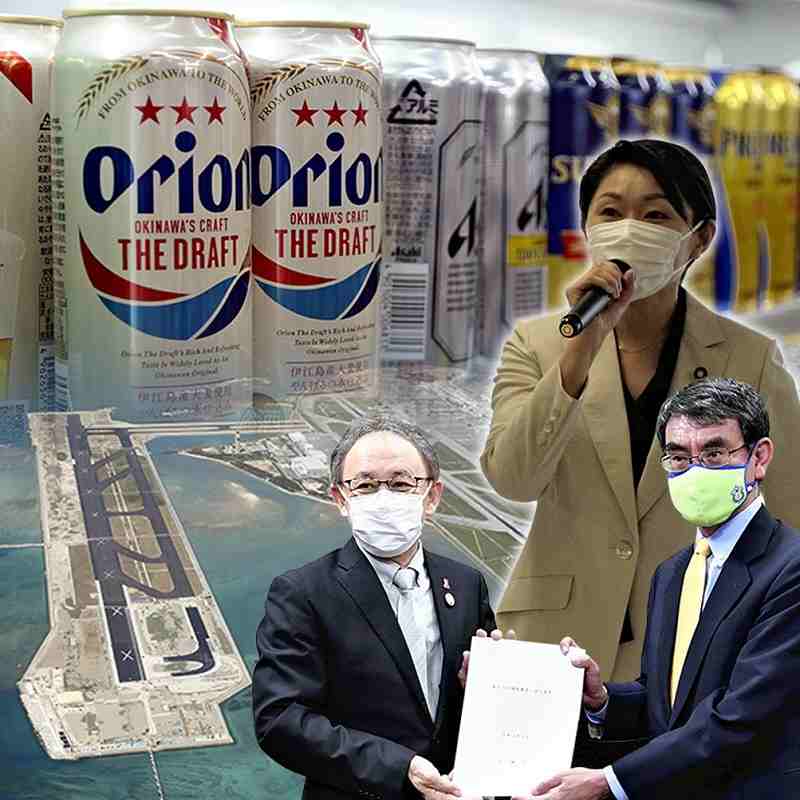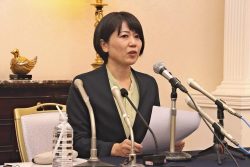
Clockwise from top left: Cans of Okinawa’s Orion beer; Yuko Obuchi, chairperson of the LDP Research Commission for the Promotion and Development of Okinawa; Taro Kono, minister of state for Okinawa, receives written requests from Okinawa Gov. Denny Tamaki; and Naha Airport’s second runway.
10:51 JST, June 30, 2021
This is the third installment of a series looking at various aspects of Okinawa today, 50 years since Tokyo and Washington agreed on its return to Japan.
“I hope we will be allowed to do our best for another five years,” Keiju Hayase, president of Orion Breweries, Ltd., said during an online meeting with the Liberal Democratic Party’s Research Commission for the Promotion and Development of Okinawa on June 10, urging an extension of a measure that reduces alcohol tax rates.
The reduced alcohol tax rates for Okinawa come under a law for special measures related to the prefecture’s 1972 reversion to Japan from the United States. The measure applies to beer manufacturers that existed before 1972 and whose products are shipped from the prefecture.
When Okinawa was under U.S. rule, a 100% sales tax was imposed on imported beer to protect the industry, including from Japan. After reversion, the existing manufacturers would have faced a crisis if that high tax was abolished without something to replace it, so the central government began the special alcohol tax reduction as a five-year measure.
This special tax measure has been repeatedly extended, but the initial 60% reduction has been gradually lowered.
Established in 1957, Orion Breweries is headquartered in Tomigusuku and the Orion brand has been popular as the beer of choice for Okinawans. In 2019, the company was purchased by Nomura Holdings Inc. and U.S. investment firm Carlyle Group through a joint company.
While Orion Breweries has long benefitted from the tax reduction measure, as the 50th anniversary of Okinawa’s reversion is approaching, however, LDP lawmakers have begun discussions about the special measure, including possibly abolishing the tax reduction.
During the online meeting, Hayase explained the company’s business strategy for improving competitiveness within five years, then exiting the tax reduction measure.
Orion Breweries’ strategy is built upon realizing the use of malt that is 100% produced in the prefecture, rather than imported, and raising its recognition as Okinawa brand.
Hayase said that dormant farmland will be used to grow barley, aiming for spillover effects for agriculture in the prefecture.
At the time of the reversion, Orion Breweries had 90% of the market share in Okinawa. The figure is now about 40% as beer from makers on the nation’s main islands have diluted much of the share.
Even with the tax reduction measure, the company’s pricing is not so competitive. The alcohol tax on a 350-milliliter can of beer is ¥70, but the amount on beer from Okinawa Prefecture is 20% lower at ¥56. Despite that, the price of a 350-milliliter can of Orion beer on the shelves of liquor shops in Naha is almost the same as that of beer produced in other parts of the nation, even slightly higher in some places.
If the tax reduction measure is scrapped, it may be a fatal blow to the company.
After hearing Hayase’s explanation, some LDP lawmakers reacted positively, including Kosaburo Nishime, a House of Representatives member from the prefecture, who said, “I could see that he is aware the prefecture cannot rely on special measures forever.”
However there is no way to predict how this measure will turn out.
The government’s policy for the promotion and development of Okinawa Prefecture by, for example, offering generous fiscal assistance to the prefectural government, is also approaching a turning point because the relevant law that is the basis for the preferential treatment will expire at the end of March.
“Simply extending the law is impossible,” lower house member Yuko Obuchi said May 19 during a meeting of the LDP Okinawa research commission she chairs.
“It’s undeniable that there are party members who question the fact that only Okinawa Prefecture has received such preferential treatment,” she added, suggesting a review of the system.
Okinawa Gov. Denny Tamaki was paying her a visit to ask for an extension of the law and to request enhancements for the development of Okinawa Prefecture, but Obuchi rejected this, saying, “A rekindling of the past is unacceptable.”
Just before his meeting with Obuchi, Tamaki visited the Cabinet Office to see Taro Kono, who is state minister for Okinawa.
Kono told the governor, “Nothing has been decided about what will happen after the end of the law on special measures.”
‘3K economy’
Fierce ground battles were fought in Okinawa Prefecture in the final days of World War II. About 120,000 residents died, accounting for a quarter of the prefecture’s population, and various infrastructure was also destroyed.
During U.S. rule, Okinawa was left behind while postwar Japan experienced its high economic growth. After reversion, large economic disparities arose between the prefecture and the rest of the nation.
Seeking to eliminate the disparities, the central government enacted the special measures law to implement preferential treatment, such as subsidies covering a high percentage of the costs for public works and tax reductions or exemptions.
According to Cabinet Office statistics, per capita income in Okinawa Prefecture in fiscal 1972 amounted to about ¥420,000, which was 58% of the nationwide average. The amount in fiscal 2017 rose to about ¥2.35 million, which is 71% of the national average, but still the lowest among all 47 prefectures.
One reason why incomes in Okinawa Prefecture grow at a sluggish pace is the lack of development in manufacturing there. The percentage of manufacturers among all industries in the prefecture is only about 4%, one-fifth the national average.
Okinawa Prefecture’s economy has been dubbed the “3K economy” as it relies on “kichi” (revenue from U.S. military bases), “kokyo jigyo” (public works) and “kanko” (tourism).
A member of the LDP research commission who has served as minister of state for Okinawa said, “Preferential treatment over many years may have hindered Okinawa Prefecture’s economy from becoming competitive.”
Senior members of the commission urge the prefectural government to present new ideas for development, but it has been difficult to come up with practical measures.
Some municipal government heads in Okinawa Prefecture have lost patience with the prefectural government’s responses. Seemingly defiant opinions have started to be voiced calling for the prefectural government to demand that the budget provided by the central governments add compensation for the prefecture’s contribution to national security, such as for accommodating U.S. military bases. The prefectural government has not accepted these calls as it would mean tolerating the existence of U.S. bases in the prefecture.
The relocation of U.S. Marine Corps Futenma Air Station in Ginowan is the largest focus of attention among issues related to U.S. bases. The prefectural government opposes the relocation to the Henoko district in Nago, but at the same time, it is demanding that the central government’s budget for the prefecture’s development should be maintained. Tamaki’s logic is that the central government should provide the development budget regardless of whether the prefectural government cooperates with the relocation of the U.S. base.
“It should already be said out loud,” Yonaguni Mayor Shukichi Hokama said. “The prefecture’s economy is linked to the provision of land for the U.S. bases.”
¥13.5 tril. over 50 years
The central government has compiled and implemented plans for the development of Okinawa Prefecture every 10 years.
Up through the third plan for promotion of development in the prefecture that started in fiscal 1992, the priority was placed on eliminating economic disparities between the prefecture and the rest of the nation, with an emphasis placed on public works.
From fiscal 2002, the role of the plan was changed into building a self-reliant economy. The name of the plan was also changed accordingly.
The current fifth plan runs until March, allocating ¥301 billion, including ¥142 billion for public works-related purposes and ¥98.1 billion as a lump-sum grant for the prefecture to use as it wishes for this fiscal year.
To make coordination among central ministries and agencies smooth, the central government’s budges for development in the prefecture are earmarked in a lump sum as the Cabinet Office’s Okinawa development budget. Through this fiscal year, about ¥13.5 trillion in total has been provided.
The development plans realized large-scale public works for construction of facilities such as the Okinawa Churaumi Aquarium in Motobu and the second runway of Naha Airport.
"Politics" POPULAR ARTICLE
-

Japan to Support Central Asian Logistics Route That Bypasses Russia, Plan to Be Part of Upcoming Summit in Tokyo
-

Japan to Tighten Screening of Foreigners’ Residential Status by Providing Information of Nonpayment of Taxes
-

Takaichi Cabinet Approval Holds at 72% as Voters Back Aggressive Fiscal Stimulus, Child Benefits
-

Chinese, Russian Bombers Flew Unusual Path by Heading Toward Tokyo; Move Likely Meant to Intimidate Japan
-

Takaichi Meets Many World Leaders at G20 Debut in Johannesburg; Speaks with Heads of Countries Including Italy, U.K., Germany, India
JN ACCESS RANKING
-

Keidanren Chairman Yoshinobu Tsutsui Visits Kashiwazaki-Kariwa Nuclear Power Plant; Inspects New Emergency Safety System
-

Imports of Rare Earths from China Facing Delays, May Be Caused by Deterioration of Japan-China Relations
-

Japan Exports Rise in October as Slump in U.S. Sales Eases
-

Govt Aims to Expand NISA Program Lineup, Abolish Age Restriction
-

Blanket Eel Trade Restrictions Rejected

























